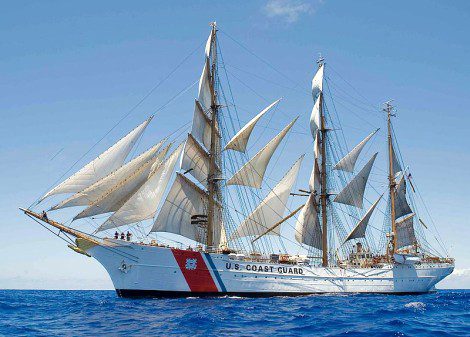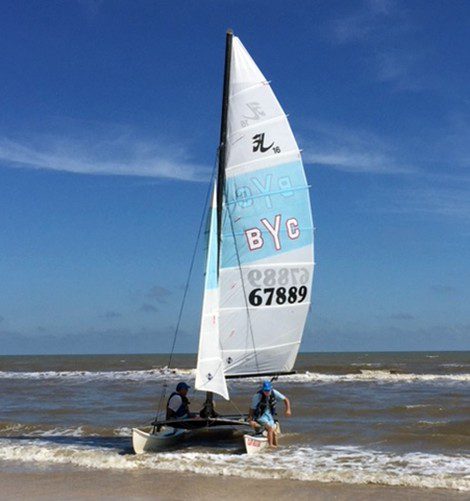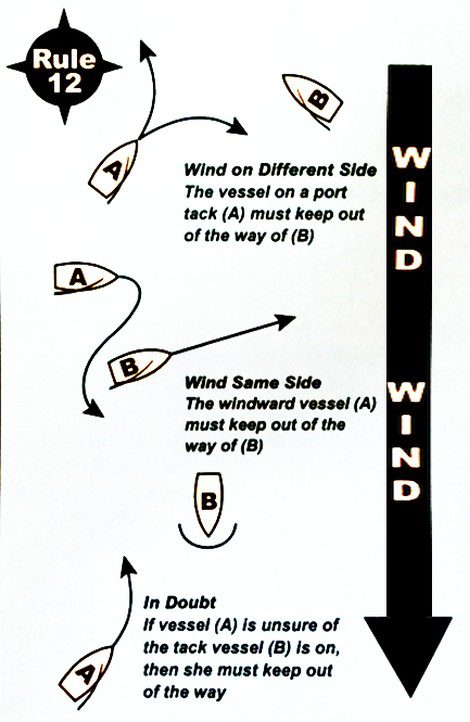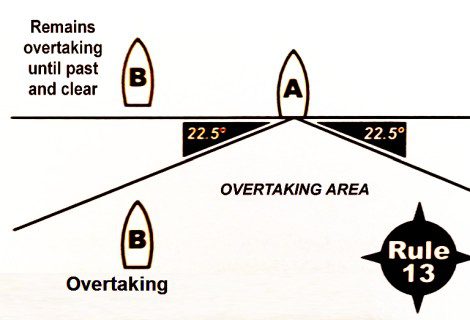 By Bob Currie, Recreational Boating Safety Specialist
By Bob Currie, Recreational Boating Safety Specialist
U. S. Coast Guard Auxiliary Station Galveston Flotilla
It has been 50 years since US Coast Guard Cutter EAGLE made a trip to Galveston. The EAGLE is a 295-foot, three-masted barque used as a training vessel for future officers of the United States Coast Guard. Built at the Blohm & Voss Shipyard in Hamburg, Germany, in 1936, it was commissioned as Horst Wessel. At the close of WWII the ship was taken as a war reparation by the U.S. The training ship will be in Galveston from June 10 through June 14, and the public will have the opportunity to board the ship during certain times each day except June 14 (day of departure). The ship will be moored at Pier 21 next to the Tall Ship Elissa. The schedule to visit the ship is below:
- June 10: Public tours from 12:00 to 4:00 pm
- June 11-13: Public tours from 11:00 am to 7:00 pm

USCG Cutter EAGLE
If you are out in your boat and encounter the EAGLE (or any other sailing vessel), you need to know which vessel has the right of way (otherwise known as the pecking order). No vessel truly has the right of way on the water; there is a prescribed pecking order though. It is not true that a sailing vessel always has the “right of way” as people like to put it; rather, each vessel has responsibilities to all other vessels. Those responsibilities are described in the Rules of the Road.
Rule 18 – Responsibilities Between Vessels (The Pecking Order)
Except where Rules 9 (Narrow Channels), 10 (Traffic Separation Schemes), and 13 (Overtaking) require:
(a) A power-driven vessel shall keep out of the way of:
(i) a vessel not under command (NUC);
(ii) a vessel restricted by her ability to maneuver (RAM);
(iii) a vessel engaged in fishing;
(iv) a sailing vessel.
(b) A sailing vessel underway shall keep out of the way of:
(i) a vessel not under command (NUC);
(ii) a vessel restricted in her ability to maneuver (RAM);
(iii) a vessel engaged in fishing.
(c) A vessel engaged in fishing while underway shall, as far as possible, keep out of the way of:
(i) a vessel not under command (NUC);
(ii) a vessel restricted in her ability to maneuver (RAM).

Bolivar Catamaran Race. Photo by Bob Currie
Rule 12 – Sailing Vessels
(a) When two sailing vessels are approaching one another, so as to involve risk of collision, one of them shall keep out of the way of the other as follows:
(i) when each has the wind on a different side, the vessel that has the wind on the port side shall keep out of the way of the other;
(ii) when both have the wind on the same side, the vessel that is to windward shall keep out of the way of the vessel that is to leeward;
(iii) if a vessel with the wind on the port side sees a vessel to windward and cannot determine with certainty whether the other vessel has the wind on the port or on the starboard side, she shall keep out of the way of the other.
(b) For the purposes of this Rule, the windward side shall be deemed to be the side opposite to that on which the mainsail is carried or, in the case of a square-rigged vessel, the side opposite to that on which the largest fore-and-aft sail is carried.
For the purpose of the Rule above, “windward” is the direction upwind from the point of reference and “leeward” is the direction away from the wind.

Exceptions to the Rule
There are three exceptions that come to mind with this rule. First, if a sailing vessel operating outside a narrow channel encounters a sailing vessel that is restricted to operating within a narrow channel, she cannot impede the restricted vessel’s progress (Rule 9, Narrow Channel Rule).
Second, if one sailing vessel is overtaking another, then according to Rule 13, the overtaking vessel shall keep out of the way of the vessel being overtaken, no matter what tack she is on or which vessel is to windward (Rule 13, Overtaking). Under Rule 13 a vessel shall be deemed to be overtaking when coming up with another vessel from a direction more than 22.5 degrees abaft her beam; that is, in such a position with reference to the vessel she is overtaking, that at night she would be able to see only the stern light of that vessel but neither of her sidelights. (Abaft means “behind or aft of a vessel’s beam.” The beam is defined as the width of a vessel at its widest point.

A vessel remains “overtaking” until it is past and clear the overtaken vessel.
Finally, if a sailing vessel is fishing, restricted in its ability to maneuver or not under command as defined in Rule 3 (General Definitions), another sailing vessel would be required to keep clear out of the way, no matter what tack the vessel was on (Rule 18, above).
What if a sailing vessel is using its auxiliary engine or is of the motor sailer type? Motor sailers are power boats with auxiliary sails, the opposite of a sailboat with an auxiliary engine; a sailboat using both its sails and an auxiliary engine is said to be motor sailing.
Rule 25 – Sailing Vessels Underway (Motor Sailing Clause)
(e) A vessel proceeding under sail when also being propelled by machinery shall exhibit forward where it can best be seen a conical shape, apex downwards. (A vessel of less than 12 meters in length is not required to exhibit this shape, but may do so.
Why is this important? It is because a sailboat that is using its auxiliary engine (with or without its sails) is by definition a power-driven vessel and the rules that apply to sailboats no longer apply; instead the rules that apply to power-driven vessels apply. The reason for this is that the sailboat using its auxiliary engine is now more maneuverable than a sailboat that is using only its sails for propulsion.
Keep Back 500 Feet
Where do we see this warning? It’s on the back of fire trucks, of course. Most cities have ordinances that require you to not follow a fire truck with its emergency lights operating any closer than 200-500 feet. There are similar Homeland Security regulations that require you to keep your distance from all military, cruise line, or commercial shipping. Do not approach within 100 yards, and slow to minimum speed within 500 yards of any U.S. naval vessel. Violators of the Vessel Protection Zone face 6 years in prison and a $250,000 fine, not to mention a quick and severe response. If you need to pass within 100 yards of a U.S. naval vessel in order to ensure a safe passage in accordance with the Navigation Rules, you must contact the U.S. naval vessel or the Coast Guard escort vessel on channel 16. Approaching certain other commercial vessels may result in an immediate boarding.
Summary
Although the Houston Ship Channel is the busiest commercial vessel port in the U.S., it is also home to quite a variety of recreational vessels, including sailboats. You must know and follow the rules when operating near other vessels, as the rules do not treat all vessels equally. Be sure you know where you fall in the pecking order and operate accordingly.
For more information on boating safety, please visit the Official Website of the U.S. Coast Guard’s Boating Safety Division at www.uscgboating.org. Questions about the U.S. Coast Guard Auxiliary or our free Vessel Safety Check program may be directed to me at [email protected]. SAFE BOATING!
[Jun-7-2022]

 Posted in
Posted in 
























